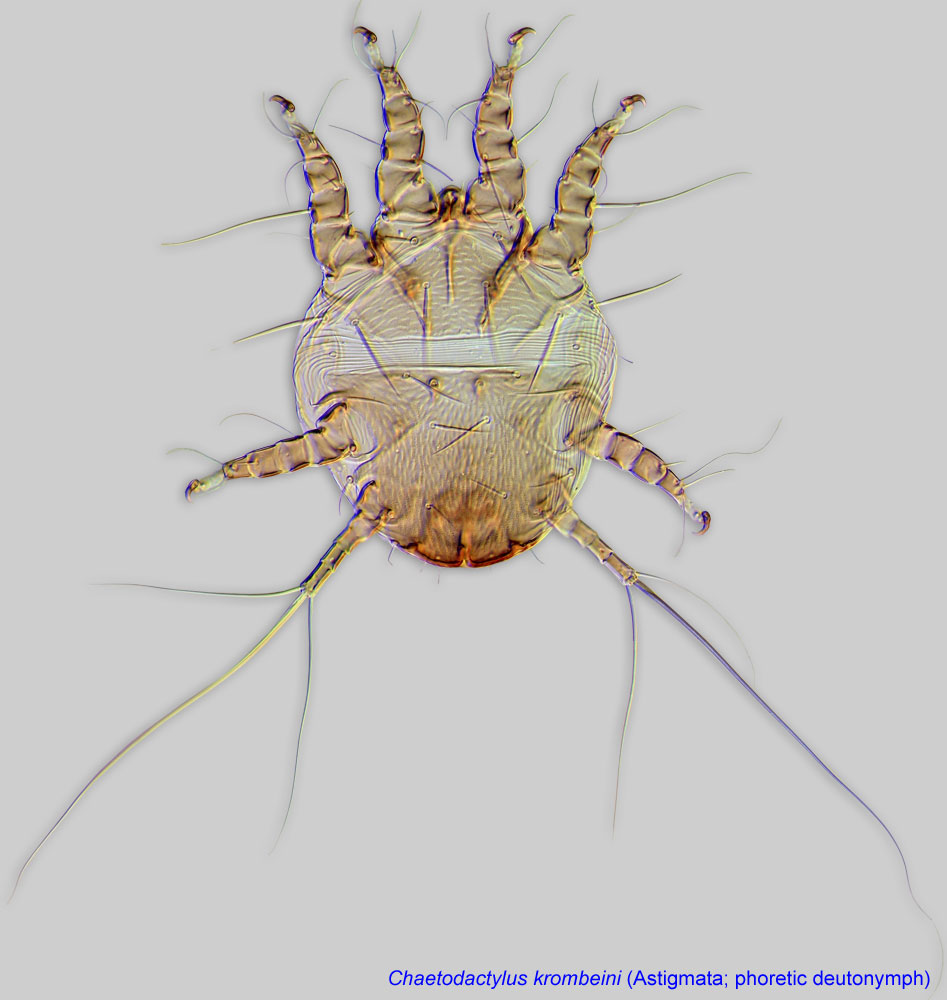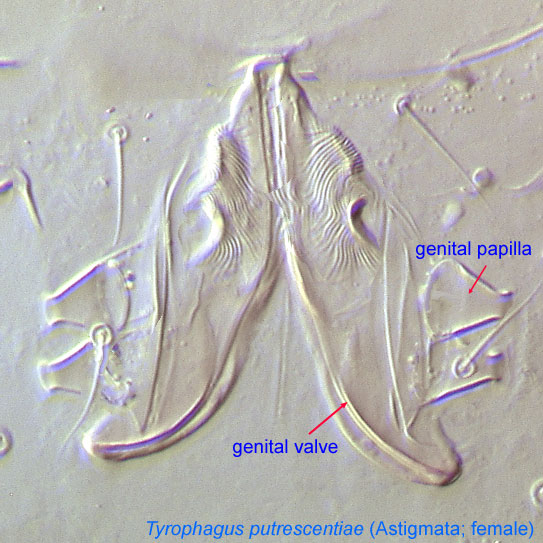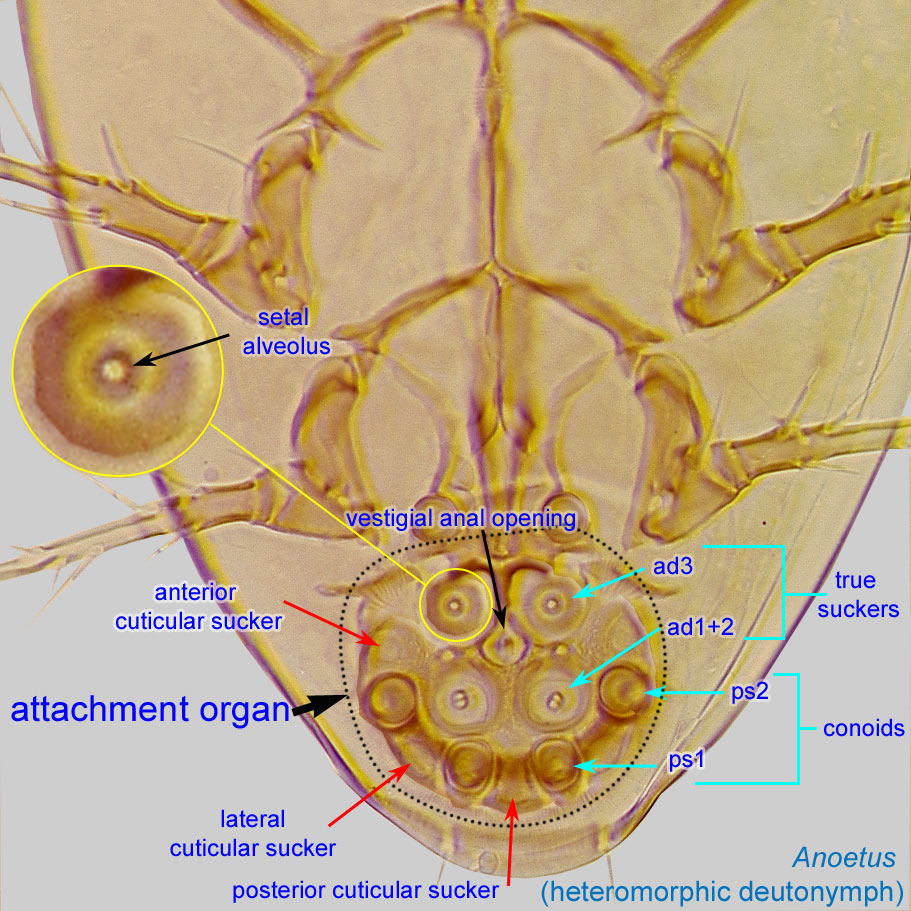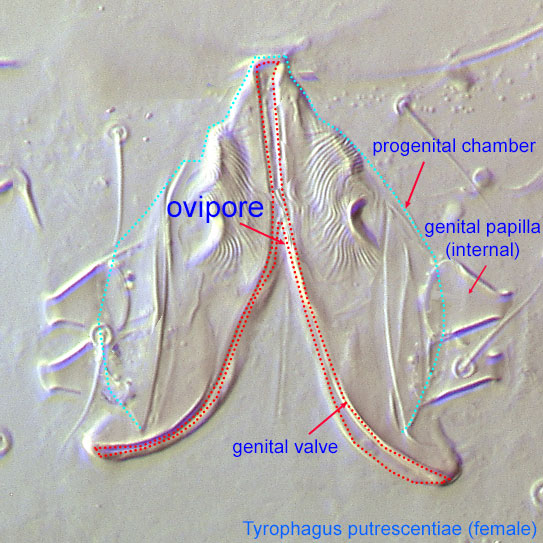The life stages that are useful for identifying mites are adults and specialized dispersal stages called phoreticphoretic:
Pertaining to phoresy; using another organism (i.e., a host) for dispersal to new habitats. Phoresy can be distinguished from parasitism because feeding typically does not occur during phoresy.
deutonymphsdeutonymph:
Ontogenetic stage between protonymph and tritonymph (or adult, if tritonymph is absent). See <a href="index.cfm?pageID=1720">Life stages page</a> for more details. . If you sample from mites on an adult bee, almost every specimen will be either a phoreticphoretic:
. If you sample from mites on an adult bee, almost every specimen will be either a phoreticphoretic:
Pertaining to phoresy; using another organism (i.e., a host) for dispersal to new habitats. Phoresy can be distinguished from parasitism because feeding typically does not occur during phoresy.
deutonymphdeutonymph:
Ontogenetic stage between protonymph and tritonymph (or adult, if tritonymph is absent). See <a href="index.cfm?pageID=1720">Life stages page</a> for more details. or a female, both of which are useful for identification. In some Prostigmata that are permanentpermanent:
or a female, both of which are useful for identification. In some Prostigmata that are permanentpermanent:
associated exclusively with bees or their close relative, wasps; cannot live without these hosts
parasites, adult males and juveniles may also be found. If you sample from an adult bee's internal tracheae or air sacs, adult mites are the most important stage for identification. And if you sample from a bee nest, the best strategy is to obtain adults by collecting as many mites as possible. While adults, especially females, are the largest stage, the immature stages are usually more numerous in nests, and it is not always possible for non-acarologists to confidently distinguish adults (especially males) under a dissecting microscope. A large sample should ensure that adults are included.
Mites may pass through up to six instars: prelarva, larva, protonymphprotonymph:
Ontogenetic stage between larva and deutonymph. See <a href="index.cfm?pageID=1720">Life stages page</a> for more details.
, deutonymphdeutonymph:
Ontogenetic stage between protonymph and tritonymph (or adult, if tritonymph is absent). See <a href="index.cfm?pageID=1720">Life stages page</a> for more details. , tritonymphtritonymph:
, tritonymphtritonymph:
Ontogenetic stage between the deutonymph and adult. Sometimes this stage is absent and deutonymph transforms directly to the adult stage. See <a href="index.cfm?pageID=1720">Life stages page</a> for more details.
, and adult. These developmental stages may look different or may be omitted depending on the mite group. All mites have an adult stage; the female is the dispersal stage in some Mesostigmata and Prostigmata. DeutonymphsDeutonymph:
Ontogenetic stage between protonymph and tritonymph (or adult, if tritonymph is absent). See <a href="index.cfm?pageID=1720">Life stages page</a> for more details. may also be the dispersal stage in Mesostigmata and Astigmata. The deutonymphdeutonymph:
may also be the dispersal stage in Mesostigmata and Astigmata. The deutonymphdeutonymph:
Ontogenetic stage between protonymph and tritonymph (or adult, if tritonymph is absent). See <a href="index.cfm?pageID=1720">Life stages page</a> for more details. is unspecialized or slightly specialized in Mesostigmata.
is unspecialized or slightly specialized in Mesostigmata.
In Astigmata, the larva, protonymphprotonymph:
Ontogenetic stage between larva and deutonymph. See <a href="index.cfm?pageID=1720">Life stages page</a> for more details.
, tritonymphtritonymph:
Ontogenetic stage between the deutonymph and adult. Sometimes this stage is absent and deutonymph transforms directly to the adult stage. See <a href="index.cfm?pageID=1720">Life stages page</a> for more details.
, and adult are usually feeding ontogenetic stages, though exceptions occur, while the deutonymphdeutonymph:
Ontogenetic stage between protonymph and tritonymph (or adult, if tritonymph is absent). See <a href="index.cfm?pageID=1720">Life stages page</a> for more details. serves for dispersal or survival in severe conditions, lacks mouthparts, and cannot feed (though non-oral feeding is possible in several taxa). DeutonymphsDeutonymph:
serves for dispersal or survival in severe conditions, lacks mouthparts, and cannot feed (though non-oral feeding is possible in several taxa). DeutonymphsDeutonymph:
Ontogenetic stage between protonymph and tritonymph (or adult, if tritonymph is absent). See <a href="index.cfm?pageID=1720">Life stages page</a> for more details. have many morphological specializations for phoresyphoresy:
have many morphological specializations for phoresyphoresy:
Attaching to or boarding another organism (i.e., a host) for dispersal to new habitats. Can be distinguished from parasitism because feeding typically does not occur.
, and they are strikingly different from other life stages.
In the fact sheets we describe and illustrate adults and give specific information on what the dispersal stage is in the life cycle for each mite lineage. If this stage is not the adult female, then a dispersal stage is also described and illustrated. Consult the fact sheets to determine which life stages are relevant for identifying each genus. Below we provide general information about mite developmental stages.
This is the first ontogenetic stage in mite development. In bee-associated mites, the prelarva is inactive, non-feeding, and sac-like (no legs or mouthparts). It develops inside the egg chorion where it consumes yolk and it molts into a larva. The prelarva is absent in Mesostigmata.
This is an active, feeding instar invariably present in mite life cycles. After eclosion, larvae shed both prelarval skin and chorion. In most bee-associated mites, this is the first active stage. It is usually a weak, miniature stage, but in some groups, larvae are aggressive parasites (Parasitengona) or predators (family Cheyletidae). In contrast, in most Mesostigmata (e.g., Varroa), the larval stage is short-lived and non-feeding, sometimes remaining within the egg chorion.
 : (Oribatida and Astigmata), larvae often have Claparède organs.
: (Oribatida and Astigmata), larvae often have Claparède organs.There are three possible nymphal stages separated by molts: protonymphprotonymph:
Ontogenetic stage between larva and deutonymph. See <a href="index.cfm?pageID=1720">Life stages page</a> for more details.
, deutonymphdeutonymph:
Ontogenetic stage between protonymph and tritonymph (or adult, if tritonymph is absent). See <a href="index.cfm?pageID=1720">Life stages page</a> for more details. , and tritonymphtritonymph:
, and tritonymphtritonymph:
Ontogenetic stage between the deutonymph and adult. Sometimes this stage is absent and deutonymph transforms directly to the adult stage. See <a href="index.cfm?pageID=1720">Life stages page</a> for more details.
. One of the stages may be either permanently or optionally suppressed, resulting in only two nymphal stages. Rarely, there is only one nymphal stage. Nymphal stages are suppressed in some Trombidiformes (Podapolipidae, Tarsonemidae, and Pyemotidae). A nymphal stage can be facultativefacultative:
can complete entire life cycle without bees or their close relative, wasps
, depending on particular circumstances.
In bee-associated Astigmata, deutonymphsdeutonymph:
Ontogenetic stage between protonymph and tritonymph (or adult, if tritonymph is absent). See <a href="index.cfm?pageID=1720">Life stages page</a> for more details. are heteromorphic with respect to other stages and may also be polymorphic. There are two types of deutonymphsdeutonymph:
are heteromorphic with respect to other stages and may also be polymorphic. There are two types of deutonymphsdeutonymph:
Ontogenetic stage between protonymph and tritonymph (or adult, if tritonymph is absent). See <a href="index.cfm?pageID=1720">Life stages page</a> for more details. for these taxa: (1) phoreticphoretic:
for these taxa: (1) phoreticphoretic:
Pertaining to phoresy; using another organism (i.e., a host) for dispersal to new habitats. Phoresy can be distinguished from parasitism because feeding typically does not occur during phoresy.
deutonymphdeutonymph:
Ontogenetic stage between protonymph and tritonymph (or adult, if tritonymph is absent). See <a href="index.cfm?pageID=1720">Life stages page</a> for more details. , an active and typically non-feeding stage serving for attachment and dispersal on insect hosts; and (2) non-phoretic (or immobile) deutonymphdeutonymph:
, an active and typically non-feeding stage serving for attachment and dispersal on insect hosts; and (2) non-phoretic (or immobile) deutonymphdeutonymph:
Ontogenetic stage between protonymph and tritonymph (or adult, if tritonymph is absent). See <a href="index.cfm?pageID=1720">Life stages page</a> for more details. , a highly regressive, cyst-like stage serving for survival in adverse conditions. The phoreticphoretic:
, a highly regressive, cyst-like stage serving for survival in adverse conditions. The phoreticphoretic:
Pertaining to phoresy; using another organism (i.e., a host) for dispersal to new habitats. Phoresy can be distinguished from parasitism because feeding typically does not occur during phoresy.
deutonymphdeutonymph:
Ontogenetic stage between protonymph and tritonymph (or adult, if tritonymph is absent). See <a href="index.cfm?pageID=1720">Life stages page</a> for more details. is a facultativefacultative:
is a facultativefacultative:
can complete entire life cycle without bees or their close relative, wasps
stage; it only appears when there is a need for dispersal. Many bees only use nests for a single generation, so mites feeding on pollen inside those nests are doomed unless they can disperse to other nests that have adult bees. The life cycle of mites is therefore synchronized with that of their bee hosts, and the dispersal stage appears when adult bees are about to emerge and leave the nest, thus dispersing mites to new nests. In bee-associated mites, non-phoretic deutonymphsdeutonymph:
Ontogenetic stage between protonymph and tritonymph (or adult, if tritonymph is absent). See <a href="index.cfm?pageID=1720">Life stages page</a> for more details. are known only in Chaetodactylus and certain species of Glycyphagus and Acarus. In Chaetodactylus, which is associated with solitary bees constructing nests only for a single generation/season, the deutonymphsdeutonymph:
are known only in Chaetodactylus and certain species of Glycyphagus and Acarus. In Chaetodactylus, which is associated with solitary bees constructing nests only for a single generation/season, the deutonymphsdeutonymph:
Ontogenetic stage between protonymph and tritonymph (or adult, if tritonymph is absent). See <a href="index.cfm?pageID=1720">Life stages page</a> for more details. remain in the nest cavity waiting for the nest to be re-used by other bees rather than dispersing.
remain in the nest cavity waiting for the nest to be re-used by other bees rather than dispersing.
 :: the protonymphprotonymph:
:: the protonymphprotonymph: 2 pairs, and tritonymphtritonymph:
2 pairs, and tritonymphtritonymph: , deutonymphdeutonymph:
, deutonymphdeutonymph: 2 pairs, and tritonymphtritonymph:
2 pairs, and tritonymphtritonymph: is phoreticphoretic:
is phoreticphoretic: and the lack of functional mouthparts. A few taxa in the families Chaetodactylidae, Glycyphagidae, and Acaridae have non-phoretic, immobile deutonymphsdeutonymph:
and the lack of functional mouthparts. A few taxa in the families Chaetodactylidae, Glycyphagidae, and Acaridae have non-phoretic, immobile deutonymphsdeutonymph: . This stage is a featureless sack with greatly reduced legs, attachment organattachment organ:
. This stage is a featureless sack with greatly reduced legs, attachment organattachment organ: , and mouthparts, and it usually stays under the protonymphal skin.
, and mouthparts, and it usually stays under the protonymphal skin.The adult is a sexually mature stage that cannot molt anymore, though rare instances of adult molts are known.
 , and the male has either an aedeagusaedeagus:
, and the male has either an aedeagusaedeagus: is present in Astigmata, Prostigmata (Tetranychidae), and some Parasitiformes (Dermanyssina and Heterozerconina). In these cases, the oviporeovipore:
is present in Astigmata, Prostigmata (Tetranychidae), and some Parasitiformes (Dermanyssina and Heterozerconina). In these cases, the oviporeovipore: and copulatory opening are separate and disconnected.
and copulatory opening are separate and disconnected.For bee-associated mites, there are typically two primary habitats where various life stages of mites can be found: adult bees and their nests. There are three different combinations of these habitats.
 , and adult males and females) occurs in the nest, but fertilized females can also be found on adult bees. So here, the female is both a phoreticphoretic:
, and adult males and females) occurs in the nest, but fertilized females can also be found on adult bees. So here, the female is both a phoreticphoretic:In this tool, we use the terms "feeding stage" and "non-feeding stage" only for the members of Astigmata to distinguish the phoreticphoretic:
Pertaining to phoresy; using another organism (i.e., a host) for dispersal to new habitats. Phoresy can be distinguished from parasitism because feeding typically does not occur during phoresy.
deutonymphdeutonymph:
Ontogenetic stage between protonymph and tritonymph (or adult, if tritonymph is absent). See <a href="index.cfm?pageID=1720">Life stages page</a> for more details. from other stages. In Astigmata, this stage is always non-feeding, in contrast to the other stages in this group's life-cycle (i.e., adults, tritonymphstritonymph:
from other stages. In Astigmata, this stage is always non-feeding, in contrast to the other stages in this group's life-cycle (i.e., adults, tritonymphstritonymph:
Ontogenetic stage between the deutonymph and adult. Sometimes this stage is absent and deutonymph transforms directly to the adult stage. See <a href="index.cfm?pageID=1720">Life stages page</a> for more details.
, protonymphsprotonymph:
Ontogenetic stage between larva and deutonymph. See <a href="index.cfm?pageID=1720">Life stages page</a> for more details.
, and larvae), which, for bee-associated mites, are always feeding stages. In other groups of bee mites, other stages may be non-feeding. For example, larvae are non-feeding in Varroa, and some Heterostigmata adult males may be non-feeding. Similarly, phoreticphoretic:
Pertaining to phoresy; using another organism (i.e., a host) for dispersal to new habitats. Phoresy can be distinguished from parasitism because feeding typically does not occur during phoresy.
stages may be non-feeding during phoresyphoresy:
Attaching to or boarding another organism (i.e., a host) for dispersal to new habitats. Can be distinguished from parasitism because feeding typically does not occur.
(as in females of Heterostigmata and some Mesostigmata, and deutonymphs of some Mesostigmata), but are feeding when not phoreticphoretic:
Pertaining to phoresy; using another organism (i.e., a host) for dispersal to new habitats. Phoresy can be distinguished from parasitism because feeding typically does not occur during phoresy.
. We recognize that using the terms "feeding stage" and "non-feeding stage" may be confusing for other groups, so in this tool we use these terms only for Astigmata.